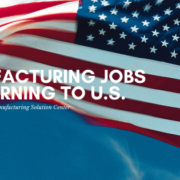How Has Manufacturing Changed in the last 10 Years
/0 Comments/in Manufacturing News /by manufacturingsolutioncenter_11vhonOver the past ten years, the manufacturing industry has been completely upgraded in their processes, standards and goals. The manufacturing plant has entirely overhauled and will continue to evolve thanks to huge advances in technology. The manufacturing industry is seeing huge shifts in increased automation in the factory and throughout the entirety of the manufacturing business.
In order for a manufacturing business to be successful today, they must invest in an ERP (Enterprise-Resource Planning) System. An effective ERP System is a company database with diverse functions for all business units, particularly the manufacturing plant. It allows the user to track a finished product throughout all phases of the manufacturing process, see the raw materials in the product, the packaging, all via lot number, etc. For finance, it allows the user to see all account payable and receivables, all product costs, BOMs (Bill of Materials) for the products.
ERP systems can be costly depending on the company used, and the features of the program needed. However, for a manufacturing business to survive the next ten years it is imperative they invest in an ERP system. With the automation of processes, the ERP system streamlines the manufacturing process. It connects to all machinery in the plant for maintenance to be preventative, not reactive. Preventative maintenance on plant machinery decreases downtime of the machine, decreases product waste, therefore increasing revenue.
Over the next ten years, if a manufacturing business does not have an ERP system, you could expect to see them out of business, or consistently not hitting the company goals and not growing as a business.
Manufacturing Jobs Returning to U.S.
/0 Comments/in Manufacturing News /by manufacturingsolutioncenter_11vhonFrom its inception to today, manufacturing has transformed. From individual companies producing and distributing their own products to a complex global network of manufacturing facilities, suppliers and distributors. Because of this global network, manufacturing has become a worldwide open market. Production has been delegated to counties with cheaper labor costs to gain the advantages a company needs in the current market.
As technology has transformed the modern manufacturing plant, whereas human labor is being replaced by technological advances, manufacturing facilities are returning to the US. The US has redesigned the production facilities, and the labor force requires a higher skill level in order for the plant to not only operate but operate effectively.
The manufacturing jobs that are returning to the US are higher skill and less physically intensive. The jobs with the highest physical labor costs are routed to the low-cost labor nations such as China, Indonesia and Slovakia.
There is a huge Reshoring Initiative that works to bring manufacturing jobs back to US soil. The top reasons for reshoring are a higher skilled taskforce, lower inventory (which reduce storage costs), higher product qualities and consistency, minimal intellectual property and regulatory compliance risks.
Some of the largest companies in the United States are reshoring back to US soil. This list includes Apple, Boeing, Ashley furniture, Ralph Lauren, Starbucks and Under Armor. There has been an estimated 750,000 jobs brought back to the US from January 2010 to present day.
What Manufacturing Sectors are Growing?
/0 Comments/in Manufacturing News /by manufacturingsolutioncenter_11vhonManufacturing is booming. With technological advances, the manufacturing process has been streamlined and transformed from high physical labor to machinery. These are the 10 manufacturing sectors that are growing within the last five years.
- Transportation – this sector has added over 270,000 jobs, a 20% increase
- Fabricated Metal Products – has added over 100,000 jobs, an 8% growth
- Food Products – added 100,000 jobs, a 7% increase
- Plastic and Rubber Products – added 75,000 jobs, a 12% increase
- Beverages – 66,000 jobs, an astounding 39% growth
- Machinery – added 50,000 jobs, a 5% increase
- Wood products – added 31,000 jobs, a 9% growth
- Nonmetallic Mineral products – added 15,000 jobs, a 4% growth
- Chemicals and Primary Metals – 20,000 jobs, a 4% increase
- Electrical Equipment and Appliances – added 9,000 jobs, a 2% increase
- Furniture – 6,000 jobs, a 1% increase
Many of those sectors are tied to Construction, which itself saw a 57% increase since 2014. This is reflected in chemical and energy related initiatives. The number is expected to taper down to a steady 16% increase in 2020. This is due to population growth, initiatives for renewable energy and continued climate change proposals.
Manufacturing with Bamboo
/0 Comments/in Manufacturing News /by manufacturingsolutioncenter_11vhonBamboo as a raw material in manufacturing is incredibly lucrative. The uses of the plant range from toothpicks to fabrics, dishes to building supplies. Its sustainable, bamboo can grow up to four feet PER DAY and only requires sunlight, water and soil to flourish.
Bamboo plantations are rapidly increasing, particularly in the tropical and subtropical regions. For some of the economically challenged countries, these plantations provide an economic booster. Since these plantations provide favorable economic possibilities, it also positively impacts the export business for the native countries. Each product made with bamboo requires diverse manufacturing facilities, therefore growing the native economy by providing multiple factories, creating more jobs and enrichening lives.
There is a natural antimicrobial property to bamboo. This is especially important in the manufacture of plates, bowls and cutlery. Fabrics are also beneficial for the antimicrobial property of bamboo since the fibers inside of the bamboo are composed of cellulose. The cellulose is mechanically separated and treated with sodium hydroxide. The fibers are then chemically bleached and bonded with carbon disulfide. Unfortunately, the chemical use with the bamboo is not environmentally friendly, but it is the favored method.
For a more environmentally friendly approach, the bamboo cellulose fiber is extracted without chemicals. Bamboo is first crushed, then natural enzymes are added. The natural enzymes break down the bamboo and the fibers are combed out. This method is incredibly time consuming but is awarded the well-coveted “organic” seal of approval.
Bamboo stalks contribute to the manufacturing of bamboo flooring and composite. The bamboo itself needs to be aged at least six years before harvesting for flooring. As in any timber manufacturing, the bamboo is split and sliced. Color may be deepened by steaming the bamboo, although a side effect of steaming is a softening of the bamboo material. After steaming, the bamboo is kiln dried. Typically, large amounts of formaldehyde (a carcinogen) is used in the glues used to bind the pieces of bamboo together for the flooring product. Assembled pieces are then milled to set size requirements and sealed.
There are a few concerns when manufacturing with bamboo mainly due to the chemicals used for flooring, composite and textiles. The procedures could create toxic byproducts which are emitted into the air and water supply. Farmers, in struggling nations, end up abandoning food crops in the more lucrative bamboo farming practices. Most of these nations have little to no regulations or standards when growing bamboo. This adds to pollution and threaten human health. Once government regulations develop for these nations manufacturing bamboo, bamboo will be able to surpass cotton as the preferred fiber. This is mainly due to the limited amount of land and resources bamboo needs as opposed to cotton that requires more land and resources.
About Us
We are dedicated to providing the best news and information for the Manufacturing Industry.




